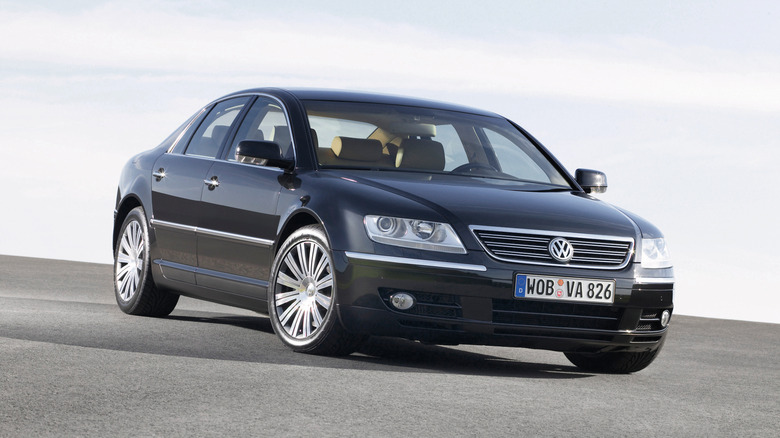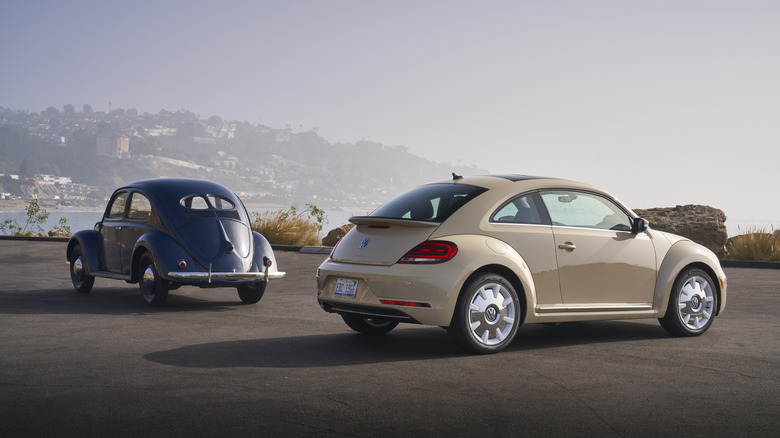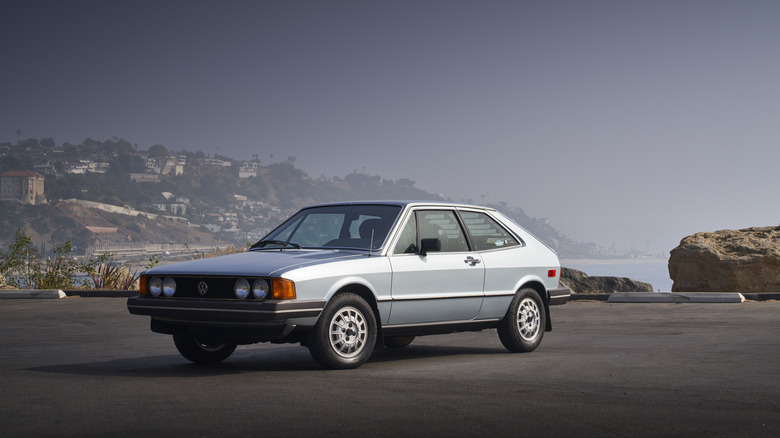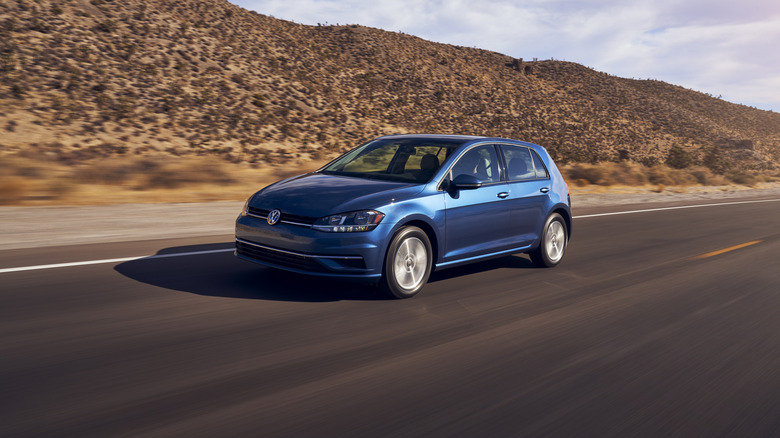5 Cars Volkswagen Should Have Never Discontinued
The first VWs sold in the U.S. were a pair of Type 1 Beetles imported in January of 1949 by the Dutch car dealer Ben Pon. Mr. Pon couldn't break open the American market, but immediately after his attempt, the Austrian-born New Yorker Max Hoffman became Volkswagen's exclusive importer until 1953. By then, Americans were beginning to catch on to the little car's appeal, and Volkswagen of America was formed in 1955 to support the marque's growing popularity in the United States. By the 1960s, Volkswagen's vehicles were firmly established as an imported alternative to larger cars from Detroit.
In its early decades in America, Volkswagen's marketing often sought to position the brand as a way for drivers to enjoy German engineering at a more affordable price than rivals like BMW or Mercedes. From body structures to suspension bushings to the feel of the controls, VWs have traditionally been solid cars, offering a confident driving experience and reliable handling. In recent years, Volkswagen has attempted to move upmarket and reposition itself as a more premium brand. This move is separate from luxury car brands owned by Volkswagen, and affects the Volkswagen marque itself.
The company has achieved mixed results. Some traditionally affordable models have dropped entry-level trims, leaving economy-minded buyers without an option on VW dealer lots. At the same time, Volkswagen has attempted to challenge luxury brands directly with premium and ultra-premium models, only to find that car buyers were skeptical of a VW badge on a vehicle in a Mercedes price range. As a result of Volkswagen's changing priorities and shifting fortunes, some models have disappeared that we'd like to see come back. Here are five cars we believe Volkswagen should never have discontinued.
Volkswagen Phaeton
Volkswagen announced its upscale ambitions with a bold gamble: the Phaeton, a 12-cylinder luxury car with a $100,000 price tag and the appearance of a classy Passat limousine. The Phaeton was a shot across the bow of Mercedes-Benz and other luxury car makers. Volkswagen introduced it in Europe in 2002 and brought it to North America in 2004. It only lasted through 2006 in that market and was ultimately discontinued in Europe as well, after 2016.
The main reason Volkswagen discontinued its most luxurious car is fairly obvious: the price tag. The name Volkswagen means "the people's car" in German and reflects the company's original mission of building affordable transportation. Well-heeled buyers in the United States who had grown up owning old Beetles and Microbuses in their wilder, younger days rejected the Phaeton, leading to its quick disappearance from North America. In Europe, where it lasted longer, its price and the lack of a plan for a gasoline-powered successor eventually led VW to discontinue it, although there was a rumor of a future electric model that has yet to materialize.
This is a shame, because in most respects other than the price, the Phaeton was an excellent car. Developed with a $1.4 billion budget, it shared a platform with the Bentley Continental GT and the Rolls-Royce Flying Spur. Engine choices included a 4.2-liter, 335-horsepower V8 or a spectacular 6.0-liter W-12 that cranked out 420 horsepower, one of the most powerful auto engines Volkswagen ever built. All-wheel drive was standard, and the car was engineered to almost absurd degrees of luxury and driving excellence. But, oh, that price tag! Bring it back with the V8 and about $40,000 lopped off the window sticker, and this car could be a hit.
Volkswagen Beetle
The Volkswagen Beetle, perhaps above all cars, needs no introduction. The history of the rise and fall of this automotive icon dates all the way back to the 1930s. Despite its shady origins in Nazi-era Germany, the original "People's Car" would go on to achieve worldwide popularity in the post-war world. Volkswagen's factory was destroyed during the war before it could build civilian vehicles, but it was rebuilt to provide transportation for Allied troops who occupied Germany. Civilians would later buy 21 million of them worldwide. Imports of the Volkswagen Type 1 (later renamed the Beetle) in America began in the late 1940s and early 1950s; by the 1960s, it was a cultural icon.
The Beetle was canceled in the U.S. twice: first in 1979, when the Type 1 was discontinued, and again when production of the last-generation Beetle ended worldwide in 2019. Over the decades, there were only three models of the Beetle: the original, which remained in production in Mexico and Brazil until 2003; the New Beetle, which was produced between 1998 and 2011; and the last generation, which VW built between 2012 and 2019. With such extraordinary longevity and popularity, why did Volkswagen discontinue the Beetle? Blame consumers' growing preference for SUVs, as well as Volkswagen's shift to EVs.
Quality cheap cars are increasingly rare in America, with only two models stickered for under $20,000 as of the 2025 model year. The original Beetle would have competed in this price category. In 1960, the base Volkswagen Beetle sedan cost $1,565, while the base model of the similarly sized Chevy Corvair rang in at $2,038. If VW were to release a "New" New Beetle that recaptured the economical spirit of the original, it could be a hit.
Volkswagen Scirocco
Granted, it's been quite a while since we've seen a Scirocco in the U.S., as this ambitious Volkswagen never found its place i the American market. The original, Giorgetto Giugiaro-designed Scirocco debuted in Germany in 1974 and came to the U.S. a year later, lasting through the 1989 model year. The last Scirocco sold here was the second-generation version, and while a third generation was sold in Europe, that car never made its way to the U.S. market. That's a shame, because the Scirocco was arguably the most European of Volkswagen's hatchbacks in terms of its driving demeanor.
The original Scirocco was lightweight at 1,700 pounds, boasting a peppy overhead-cam four-cylinder engine, characteristics that American drivers couldn't readily find in the Detroit Big Three at the time. It was a handsome, angular little hatchback with styling that foreshadowed the design direction of future Volkswagens. The second-generation shed the upward-angled rear quarter windows and featured a large hatchback with a spoiler splitting the rear windshield. The second-gen model was also larger and pricier, but it offered a 16-valve version.
The third generation moved even further upmarket, but the higher price resulted in power upgrades like the 2.0-liter, 276-horsepower turbo model. This is the one that remained forbidden fruit for Americans, although its production ended in Europe, too, in October of 2017, a fate partly explained by Volkswagen's "Dieselgate" scandal as the company scrambled to produce electric vehicles to save its eco-conscious reputation. We think the Scirocco should come back, whether powered by a gasoline engine or electricity. Americans received a tantalizing taste of Europe's hot hatch culture almost four decades ago, and thousands of drivers would probably still prefer one over yet another bland SUV.
Volkswagen Arteon
The Arteon sailed into stiff headwinds from the moment it launched in 2019, as drivers in the U.S. and elsewhere switched their preferences to SUVs in greater numbers. This explains why Volkswagen discontinued the Arteon after the 2024 model year. The Arteon was a rare contemporary Volkswagen sedan with distinctive looks and generous size combined with good performance and tons of amenities. One could almost think of it as a slightly smaller, dramatically cheaper Phaeton, and just as worthy of being brought back.
When Car and Driver reviewed the 2023 Arteon, it concluded, "It's a very nice all-around family sedan at a time when sedans are out of favor." Despite its four-door profile, the full-sized Arteon is actually a hatchback, giving it extra cargo space. With a base price of $44,305, the Arteon offered a 300-horsepower, 16-valve, turbocharged four-cylinder engine and a choice of front-wheel drive or all-wheel drive. Car and Driver's review noted the Arteon's precise steering, 4.6-second 0 to 60 time, and wide range of driver-assist and safety technologies. The reviewer preferred the SEL R-line trim for its ambient lighting and panoramic sunroof.
For American drivers who enjoy sedans with some sporty characteristics, the Arteon is another prize lost to the growing popularity of SUVs. Sales were never great, but by 2022, they had collapsed to just 1,742 in the United States. American drivers apparently never cottoned to the fact that the Arteon offered similar performance and German engineering as more expensive cars like the Audi A7. Plus, of course, there's the rising tide of electrification, with Volkswagen planning to release an EV sedan, although as of mid-2025, it hasn't arrived yet. With better marketing, a revived Arteon could bridge that gap in VW's lineup while standing out against the sea of anonymous SUVs.
Base-model Volkswagen Golf
Volkswagen still sells Golfs in the U.S., but only in the Golf R and Golf GTI flavors. And those are terrific cars, with the Golf R and GTI offering good drivetrain specs and value for performance-oriented drivers. Yet American drivers wanting an inexpensive, basic, fun-to-drive European hatchback like the base-model Golf are completely out of luck; The species is all but dead in the U.S. Europeans still get a Golf with a 1.5-liter, turbocharged, mild-hybrid four-cylinder in 114-horsepower and 147-horsepower versions, but here in the U.S., fans of economy hatchbacks can only gnash their teeth.
The base Euro-spec Golf is hardly a Spartan runabout, either. It offers LED headlights, a 10.4-inch touchscreen, a Digital Cockpit Pro instrument panel for the driver, and a surprisingly sleek and upscale exterior with a sophisticated front fascia. Europeans get a choice of trim levels ranging from the Base edition up through the R-Line, in addition to the Golf GTI, which is sold as a separate model line.
A full model lineup like that could still thrive in the U.S. Compact and subcompact SUVs sell by the hundreds of thousands annually here, and they're essentially tall hatchbacks. The Golf offers much of the same utility, but it's lower to the ground and therefore offers better handling than almost any small SUV. Plus, Toyota's Corolla Hatchback is pushing the $24,000 mark, and the Honda Civic Hatchback starts at over $27,000. Perhaps there is room for a Golf priced in the low 20s to undercut the competition. How about it, Volkswagen?





